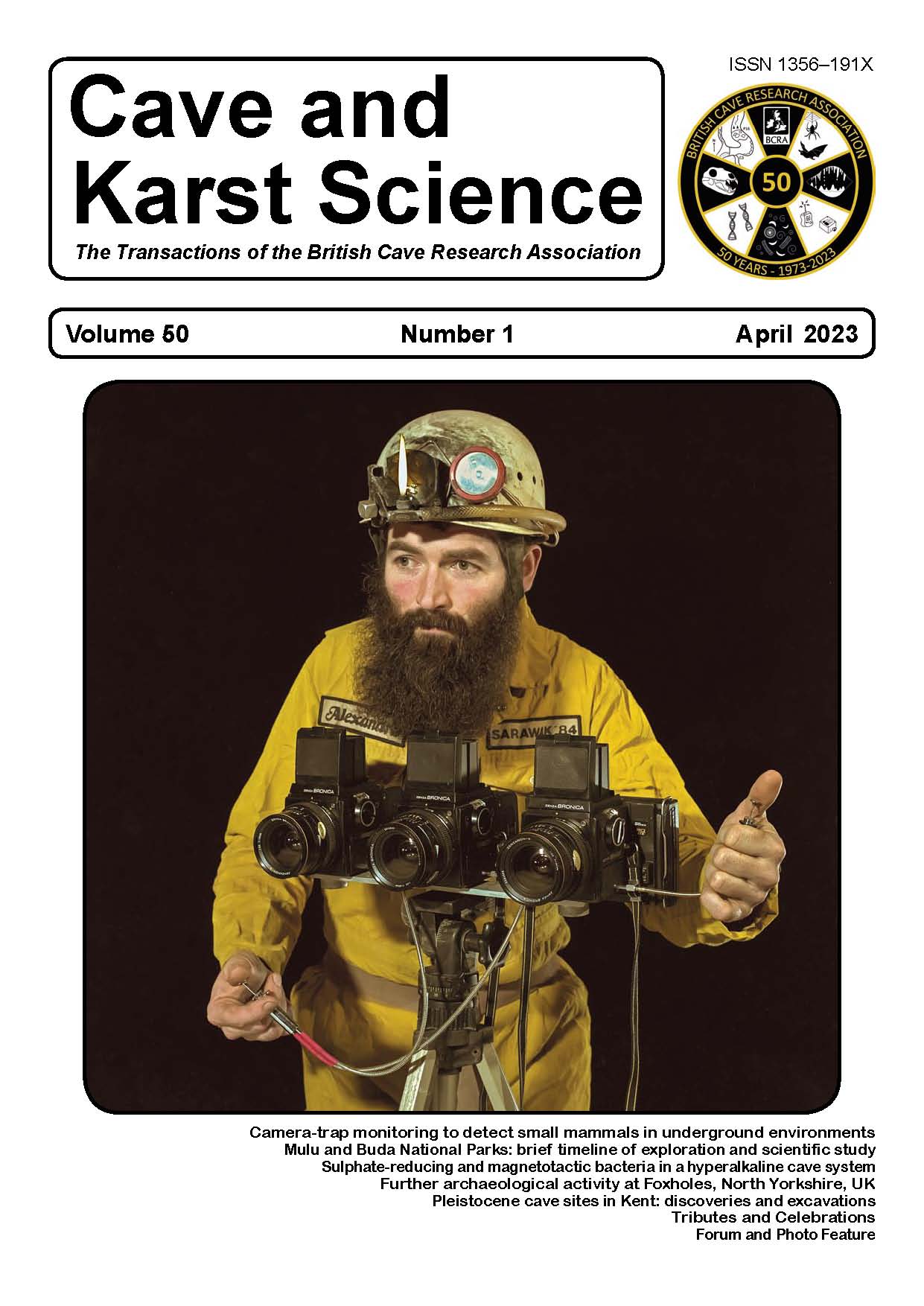
There are five main papers in the latest issue of Cave and Karst Science, looking at aspects of cave biology, archaeology and karst science. There is also, in a new departure a photo feature on corals in Wookey Hole.
Terry Reeve has been looking at available details of archaeological and Pleistocene palaeontological sites associated with early Cretaceous ragstone (hard, coarse-grained, sandy limestone) in Kent, garnered from extant historical and more recent publications. Field examination of related sites that remain locatable and accessible allows speculation regarding the whereabouts of probably cave/karst-related archaeological and palaeontological dig sites that have yielded diagnostic artefacts and fossils, including those of species that are either now extinct or no longer native to southeastern England. Based upon the limited data available it is possible to speculate regarding whether other material of potential scientific value might remain at the original sites or in geologically similar situations within the same general area.
Jianxun Shen and team have been attempting to identify sulphate-reducing bacteria (SRB) and magnetotactic bacteria (MTB) in Poole’s Cavern. These are two special groups of prokaryotes that emerged early in Earth’s history. Such extremotolerant bacterial groups have rarely been identified or studied within cave and karst environments, especially hyperalkaline cave systems (pH > 9), such as Poole’s Cavern in Derbyshire, England. In this study, they identified the sulphate-reducing MTB Desulfovibrio magneticus, within this hyperalkaline cave system. It appears to survive in a diverse range of environments including soil, stalactites and cave sediments. Additionally, various extremotolerant SRB were identified in similar Poole’s Cavern environments. We show that these SRB and MTB can move successfully into subsurface environments and adapt concomitantly to the anomalous pH, saline, and relatively nutrient-poor conditions found in Poole’s Cavern. These findings are significant to our understanding of microorganisms on early Earth because it is believed, but not proven, that underground environments might have been hot spots for early microbial life. it is expected that these early bacteria would have been able to adopt similar adaptation strategies, transferring and acclimatizing to underground environments, in ways comparable to the SRB and MTB identified in this study.
Phil Murphy has been looking at the Yorkshire Speleological Association’s records of historical archaeological activity at Foxholes (Clapdale). Contextual reconsideration of historical documentation created during excavations of cave sediments by cavers, and subsequently archived, is shown to be a practical and productive tool in terms of understanding some material from existing archaeological collections. Ancillary information contained within such notes, even in records that ultimately disprove documented relationships, can shed light not only upon the interpretation and significance of the related archaeological artefacts, but also help to confirm the fundamental accuracy and reliability of any related locational and temporal metadata.
Anna Marchewka and Tomasz Postawa describe using camera traps as a monitoring method for detecting small mammals in caves. Monitoring the distribution or abundance of mammals inhabiting caves is challenging, both due to the secretive nature of the animals and the difficulties involved in accessing these spaces. Standard monitoring methods are restricted by cave conditions. They present results from camera trap (CT) monitoring in an underground habitat, and estimate the occurrence of small mammals within it. They compared the rate of detection, proportion of empty triggers, and unidentified and identified species in two types of spaces (narrow and open) in the studied cave. Research was conducted between July and November 2018 in Niedźwiedzia Górna Cave (in the Kraków-Wieluń Upland of southern Poland), and 1,699 videos recorded during 58 trapping days were analysed. Detection rates were higher in the narrow spaces than in the open ones, and the proportion of identified bat species varied between spaces, whereas detection rates for flying and non-flying animals did not differ between spaces. Two different camera models were used during this study; there were differences in relative performance across all measurements. Six mammal species were identified: four flying species, comprising greater mouse-eared bat (Myotis myotis), Natterer’s bat (Myotis nattereri), brown long-eared bat (Plecotus auritus) and the lesser horseshoe bat (Rhinolophus hipposideros) – and two non-flying species: edible dormouse (Glis glis) and beech marten (Martes foina). Results showed that: i) CTs represent a useful tool for monitoring small mammals in caves; ii) performance differs between locations and iii) performance also varies according to CT model and configuration.
David Gill discusses the exploration of the caves and karst areas of the Gunung Mulu and Buda National Parks. This has been ongoing for 61 years, beginning with the work of G E Wilford in 1961 and is still continuing. Considering the relatively small areas of karst outcrops involved it is remarkable that a total of 549.1km of some of the largest known cave systems (by volume) has been mapped. Scientific study of the caves and deposits within them has contributed greatly to the understanding of these magnificent systems and past climatic conditions in the area. A precis of the results of dedicated work by more than 200 cave explorers and scientists, predominantly from the UK, is presented.
This issue also includes tributes to Zhu Xuewen, Andrej Kranjc and Jerry Wooldrige (who features on the front cover, above), a book review and the photo feature on derived or “unconformable” corals exposed in Land of Hope and Glory, Wookey Hole, Somerset.
Cave and Karst Science is published three times a year and is free to paid-up members of the British Cave Research Association. Members can also read it online here. Non-members may obtain copies for an annual subscription of £40 (plus postage for non-UK destinations), or online access for only £30. A discounted student subscription is available. The publication contains a wealth of information and represents excellent value for money for anyone with an interest in the science of caves. It is well-presented throughout, with a clear, attractive layout and numerous high-quality illustrations.
